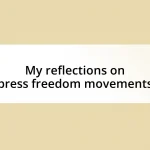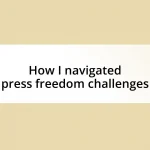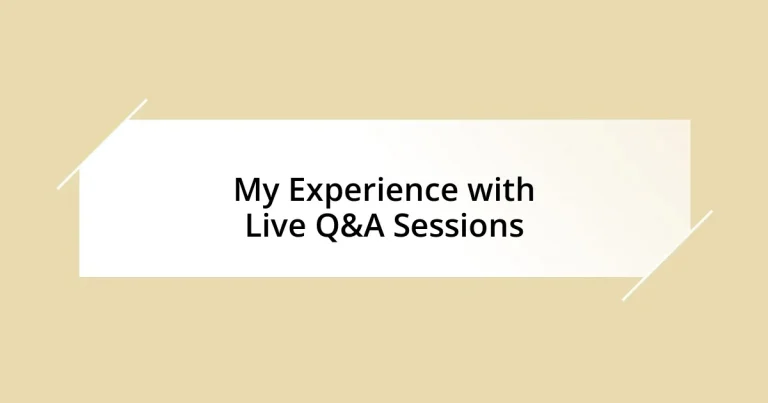Key takeaways:
- Live Q&A sessions foster real-time engagement, allowing for dynamic discussions and community building.
- Preparation is essential; having questions ready, testing technology, and creating a welcoming environment enhance participation.
- Effectively engaging an audience through personal connections, interactive questions, and humor encourages a vibrant dialogue.
- Post-session evaluation, including audience feedback and performance metrics, is crucial for continuous improvement and refining approach.
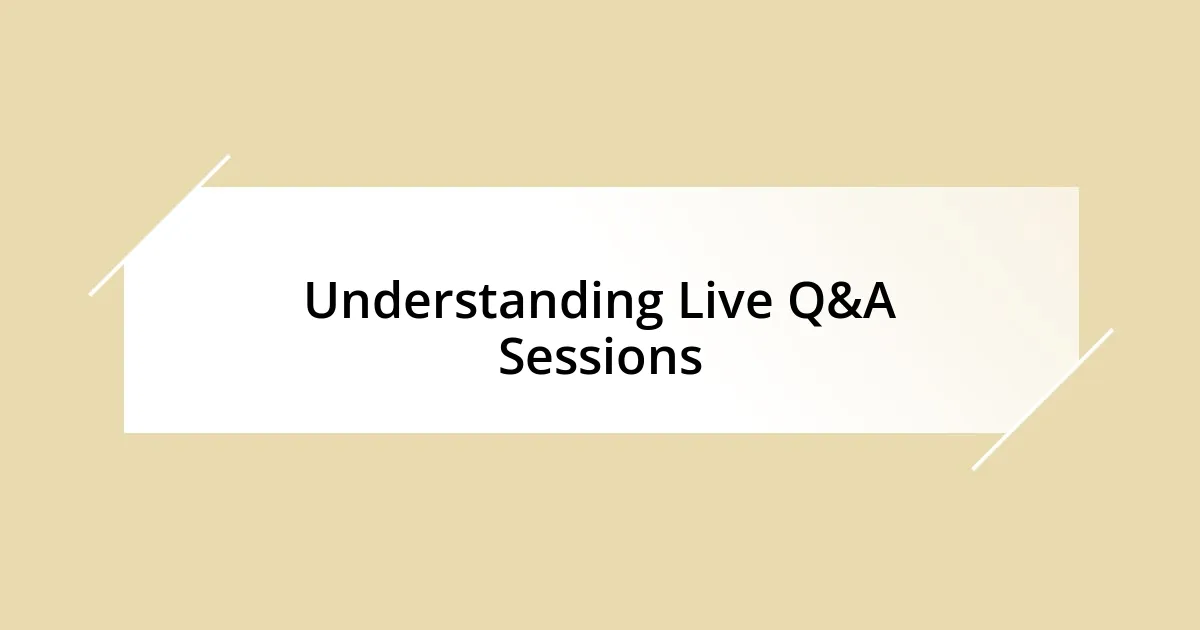
Understanding Live Q&A Sessions
Live Q&A sessions are dynamic events that allow participants to ask questions in real-time, creating a fluid and engaging atmosphere. I remember attending one of these sessions where I felt a mix of excitement and nervousness as I drafted my question, wondering if it would spark a meaningful discussion. Isn’t it fascinating how such moments can turn into opportunities for real connection and learning?
During these sessions, the instant feedback loop can transform a simple inquiry into a rich conversation. I recall when a participant asked a question that led to an unexpected debate, showcasing the diverse perspectives in the room. Have you ever experienced that moment of clarity when someone else’s question resonates with your own?
Moreover, the emotional energy in live Q&A sessions is palpable. There’s something electrifying about sharing thoughts and emotions in a crowd, whether it’s the laughter that erupts from a well-timed joke or the collective “aha” when a complex question is answered. I often find myself reflecting on how this format not only spreads knowledge but also fosters community. Don’t you think that sense of belonging is one of the greatest benefits of engaging in a live Q&A?
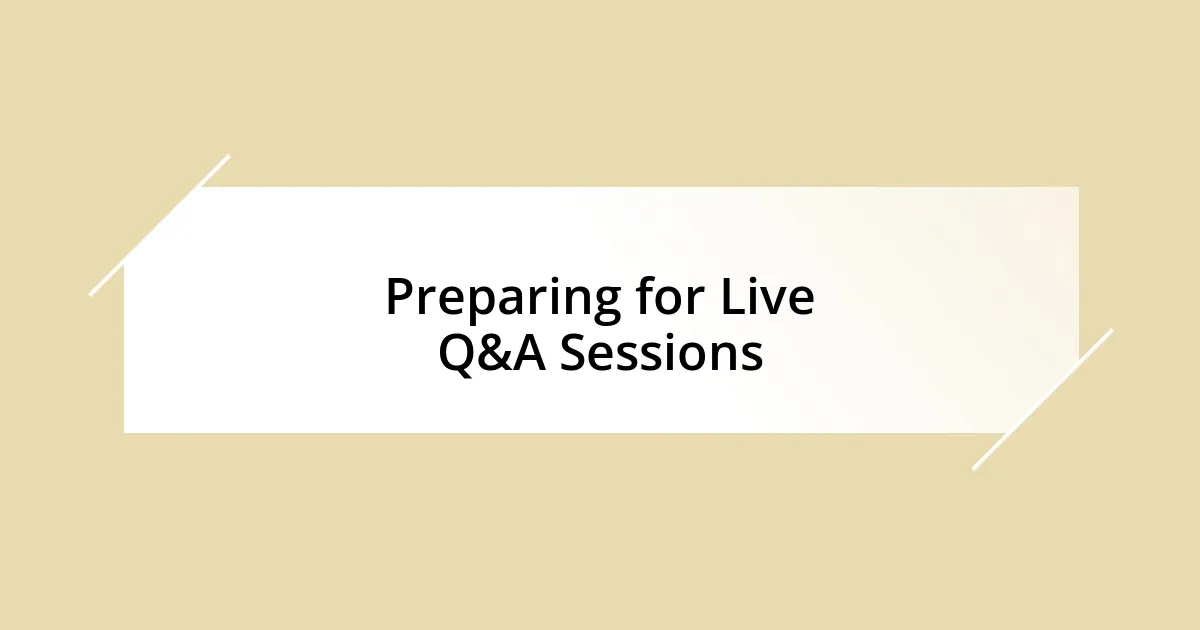
Preparing for Live Q&A Sessions
Preparing for a live Q&A session is crucial for maximizing engagement and ensuring a smooth interaction. From my experience, having a clear set of questions prepared ahead of time can help alleviate the nerves. I once attended a session where the host had a structured approach, which significantly improved the flow and allowed for deeper exploration of topics.
Additionally, testing the technology beforehand is something I cannot stress enough. I remember a time when a minor technical glitch disrupted the rhythm of a well-planned session. It emphasized to me just how vital it is to have a backup plan in place—whether it’s ensuring your microphone works or having a reliable internet connection.
Lastly, creating a welcoming environment encourages participation. When I was part of a live session where the host made a point to acknowledge audience members and their contributions, it created an inviting atmosphere. This not only made me feel valued but inspired me to engage more actively. Don’t you think fostering connectivity is key to a successful Q&A?
| Preparation Aspect | My Experience |
|---|---|
| Question Preparation | Helps to alleviate nerves and allows for deeper discussions. |
| Technical Check | Ensures a smooth event; minor glitches can disrupt flow. |
| Welcoming Environment | Encourages audience participation and engagement. |
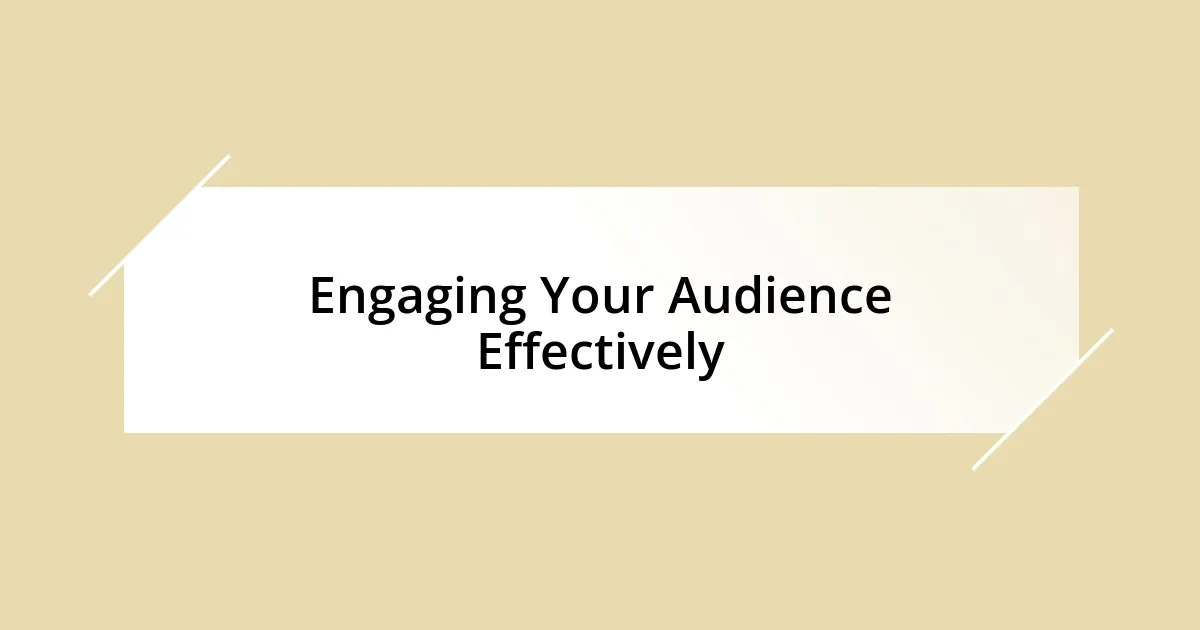
Engaging Your Audience Effectively
Engaging your audience effectively during live Q&A sessions can be a game-changer. One tactic I’ve found useful is making eye contact with participants, even if it’s through a camera. I remember one particular instance where I scanned through the virtual chat and noticed familiar names; I called them out, which sparked a wave of excitement. It’s incredible how simple gestures like this can bridge the gap between the speaker and the audience, making them feel more involved.
- Use Real Names: Acknowledge participants by their names to create a personal connection.
- Pose Interactive Questions: Ask questions that encourage audience members to think critically and respond.
- Encourage Sharing: Invite attendees to share their experiences or tips—it adds depth to the conversation and fosters a sense of community.
- Be Authentic: Sharing your own vulnerabilities or uncertainties can make you more relatable and encourage others to open up.
- Utilize Humor: A light-hearted remark can break the ice and make the environment feel relaxed and safe for discussion.
I’ve noticed that when I share a personal story or a light joke, it often leads to a more dynamic interaction. There was a memorable time when I shared a humorous mishap from my own life, and to my surprise, attendees chimed in with their stories. It created a delightful bonding moment, and I realized how humor can dissolve barriers and invite participation. Engaging an audience is about cultivating a vibrant space where everyone feels their voice matters.
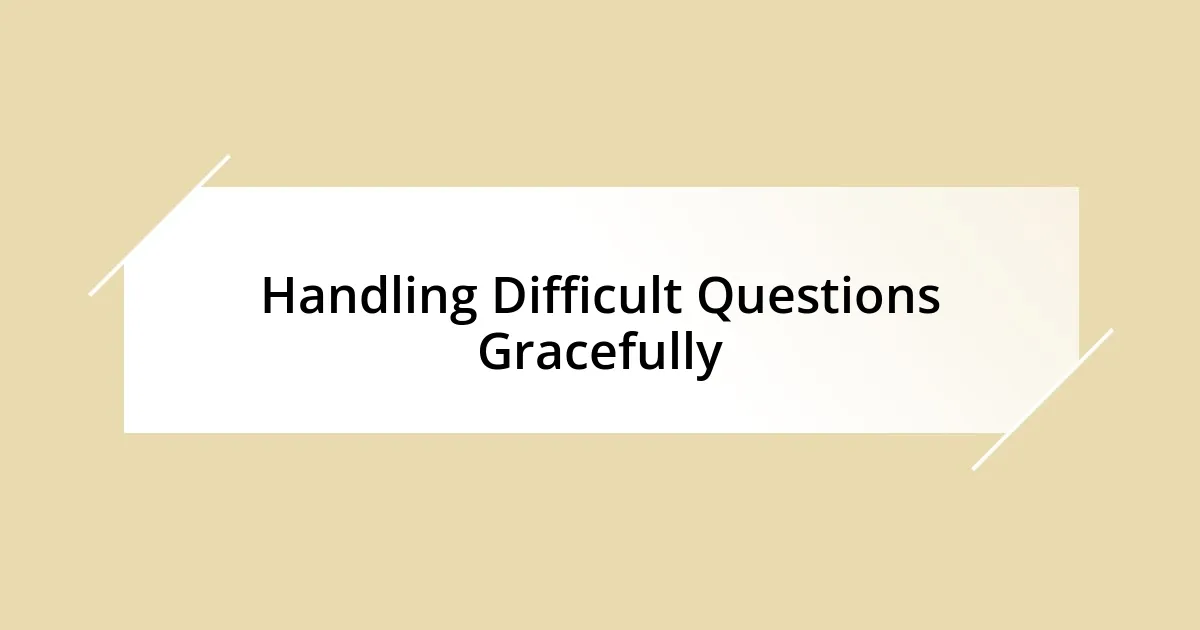
Handling Difficult Questions Gracefully
Handling difficult questions is an art, one I’ve had to refine over countless live Q&A sessions. I recall a particular instance when someone asked me a challenging question about a project failure I had experienced. Instead of brushing it off, I took a deep breath and acknowledged the situation. I shared not only the details of what happened but also the lessons I learned, which turned a potentially awkward moment into a valuable discussion. Isn’t it interesting how transparency can disarm tension?
Sometimes, the most challenging questions can stem from emotional topics, especially if they resonate deeply with your audience. I once faced a question about a controversial decision I had made in my career. Pausing for a moment, I reflected on how much my own journey impacted my choices. By responding with empathy and insight, I was able to address the question thoughtfully, which, in turn, encouraged others to share their thoughts and feelings. This interaction made me realize that vulnerability can actually strengthen connections with the audience.
Adapting your response to the mood of the session is key when navigating tough questions. In one session, a query sparked an unexpected emotional response from both me and the audience. Instead of diverting from it, I leaned into the moment and encouraged open dialogue. This created an environment where everyone felt safe to express their opinions, leading to deeper insights and richer discussions. Have you ever noticed how these moments can often become the most memorable parts of a conversation? I know I have.
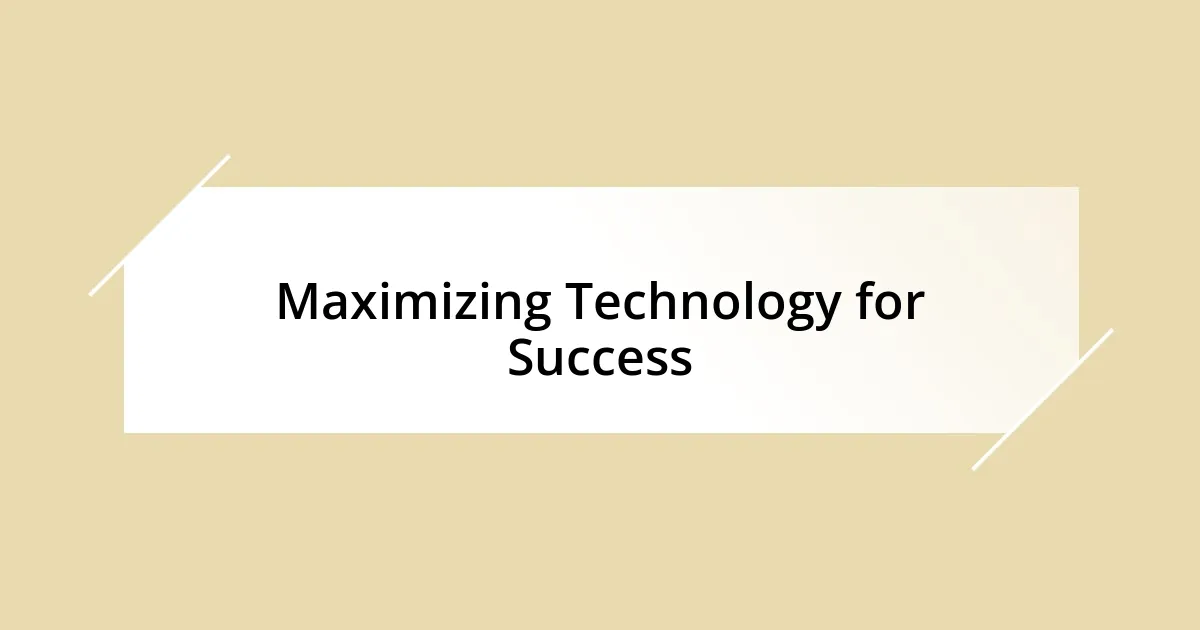
Maximizing Technology for Success
To truly leverage technology for success in live Q&A sessions, I’ve found it vital to embrace the tools at our disposal. For instance, I remember a session where I used live polling to gauge audience sentiment in real time. Seeing the quick results not only facilitated engagement but also shaped the direction of our conversation, allowing participants to feel like active contributors.
Integrating technology goes beyond just polls—using chat features effectively can transform the whole experience. During one memorable Q&A, I encouraged attendees to submit questions in advance through a chat channel. This proactive approach not only eased the flow of conversation but also allowed me to address significant topics that resonated with many, making everyone feel heard and valued. Have you tried this tactic? It’s amazing how such simple strategies can make a big difference!
Moreover, I’ve discovered that recording sessions and sharing them later can maximize the reach and impact of our discussions. After one session, a viewer reached out to say that they watched the recording, which reignited their interest in a topic I had thought only had a fleeting moment of relevance. It illuminated a powerful truth: our technology can extend the life of our interactions, fostering ongoing learning and connection long after the session has ended. How satisfying is that to know your message continues to resonate?
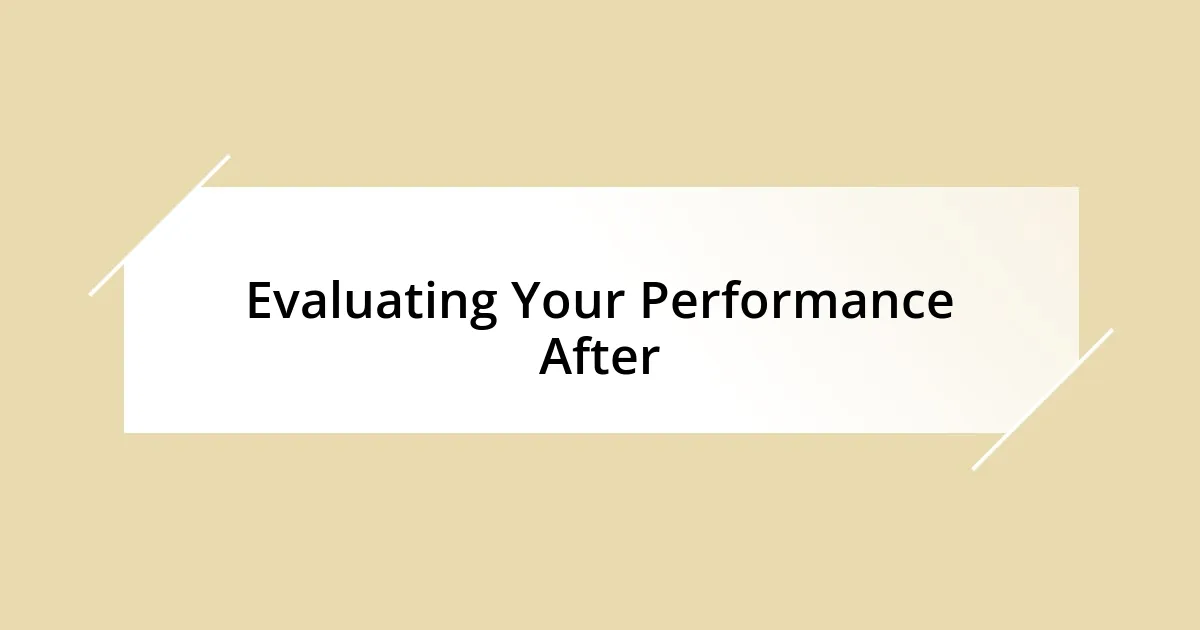
Evaluating Your Performance After
Evaluating your performance after a live Q&A session is a crucial step that, from my experience, can significantly enhance future interactions. I always set aside time to reflect on what went well and what could have been better. For instance, I keep a notepad handy and jot down specific moments where I felt particularly engaged or, conversely, lost the audience’s interest. This self-assessment helps me to identify patterns and improve my delivery.
I love revisiting audience feedback as a part of my evaluation process. There was one session where a few participants expressed they needed more clarity on a complex topic I discussed. This feedback hit home for me; it reminded me how vital it is to communicate in a way that resonates with everyone, not just the more knowledgeable ones. I often ask myself, “How can I present complex ideas in simpler terms next time?” It’s through this mindset that I continuously refine my approach.
Finally, I’ve found that sharing my reflections with others can offer extraordinary insights. After one session, I reached out to a few colleagues for their take on my performance. Their perspectives revealed things I hadn’t noticed myself, like my body language and pacing. Isn’t it fascinating how we can often blind ourselves to our own habits? Embracing this collaborative evaluation has propelled my growth, turning every Q&A into a stepping stone for improvement.
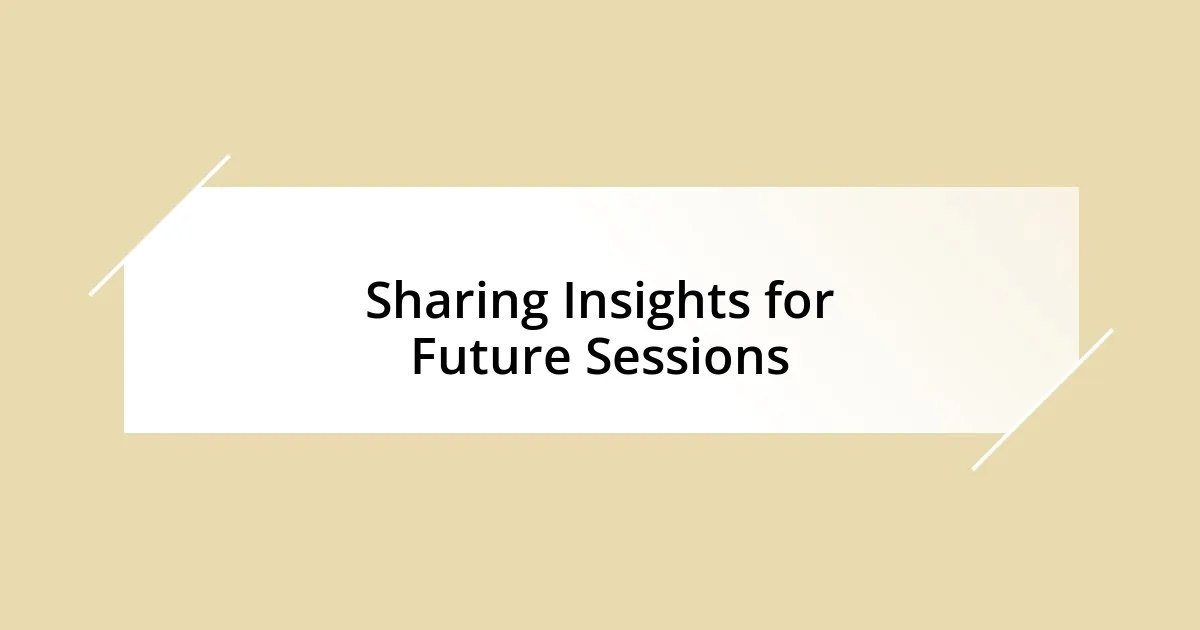
Sharing Insights for Future Sessions
Sharing insights after each session has become an invaluable part of my growth. I remember during one Q&A, a participant shared they felt overwhelmed by the volume of information presented. This feedback really struck a chord with me; it highlighted the importance of pacing and clarity. I now make it a point to simplify complex discussions, ensuring everyone stays engaged and follows along. Have you had a moment where audience feedback reshaped your approach?
Delving into analytics also provides a wealth of insights for future interactions. I once analyzed attendance metrics and discovered a drop-off rate midway through a session. This prompted me to reflect on what had shifted in our conversation around that time. Did the topic become too technical, or was it simply losing the audience’s interest? By scrutinizing these details, I’ve learned to keep energy levels high throughout. Isn’t it remarkable how data can lead to actionable insights?
Collaboration with peers opens up new doors for improvement that I hadn’t considered before. After a particularly challenging session, I hosted a coffee chat with colleagues who had attended. They shared valuable perspectives on my delivery style, including a tendency to rush through key points. I found their critiques hard to hear at first, but I genuinely appreciate the honesty. How do you react to constructive criticism? For me, it’s a vital ingredient for growth, lighting the way to refine my technique for the next Q&A.






